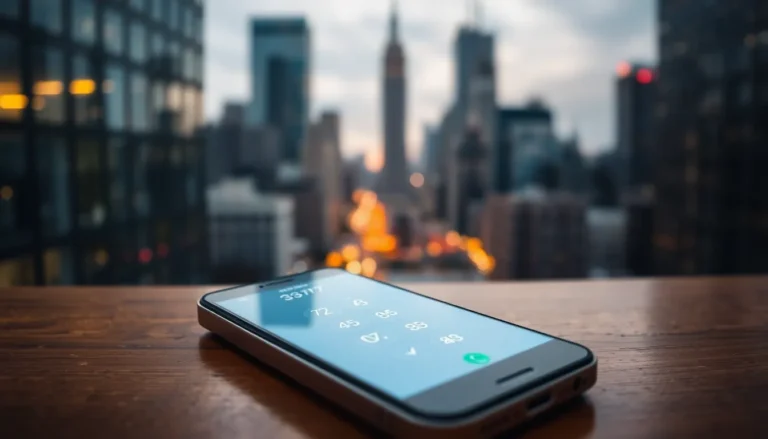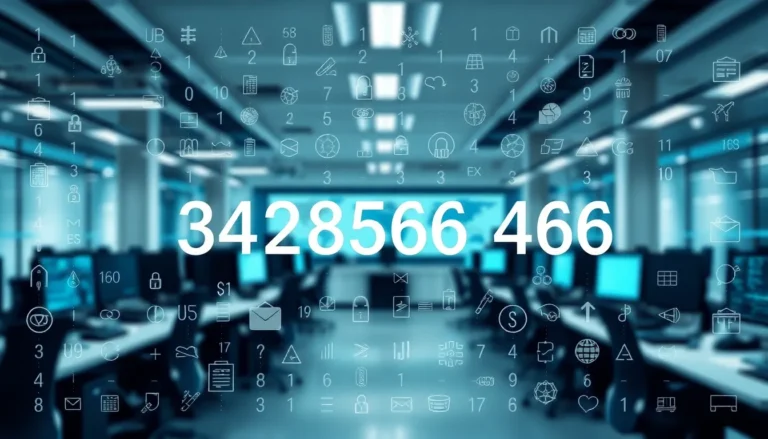Table of Contents
ToggleUpgrading to a new iPhone is like unwrapping a shiny gift, but the excitement can quickly fade when faced with the daunting task of transferring all your data. How long does this process actually take? Spoiler alert: it’s not as simple as a magic wand wave, but it doesn’t have to feel like watching paint dry either.
Overview Of iPhone Transfer Process
Transferring data to a new iPhone involves several steps that vary in duration. Users typically begin by choosing a transfer method, such as Quick Start, iCloud, or iTunes. Quick Start allows immediate setup with minimal effort, often completing within 10 to 30 minutes depending on the amount of data.
iCloud transfers require an active Wi-Fi connection. Backup and restore processes may take one to several hours. The duration largely depends on the size of the backup file. Users must ensure sufficient storage space on iCloud for successful transfers.
Using iTunes offers another pathway. This method usually takes longer, especially for large amounts of content. Users connect their iPhones to a computer, and then sync data, which can take anywhere from 30 minutes to a few hours.
Each method presents distinct advantages and challenges. Quick Start provides speed and convenience, while iCloud excels for ease of access. ITunes, though more time-consuming, benefits those who prefer working offline.
Data types also affect transfer time. Contacts, photos, and apps transfer differently based on the user’s settings. Ensuring a stable connection boosts transfer efficiency. Users notice significant delays if the Wi-Fi signal weakens during an iCloud transfer.
Users should prepare for the transition by maintaining battery life and confirming their software is up to date. With proper planning, data transfer to a new iPhone can occur smoothly and efficiently.
Factors Affecting Transfer Time
Transfer time for a new iPhone can vary based on specific factors. Data size and transfer method play significant roles in determining how long the process takes.
Data Size
Data size influences transfer speed considerably. Larger amounts of data require more time for completion. For instance, a device filled with apps, photos, and videos may take longer than one with minimal content. Users with extensive libraries should anticipate longer transfer durations. Conversely, those with less data can expect quicker results. Each file type has its own size, which can also affect overall time, as photos and videos tend to take up more space.
Transfer Method
Transfer method greatly impacts how quickly data moves. Quick Start enables fast transfers, often within 10 to 30 minutes. iCloud offers convenience but can take one to several hours, depending on backup size and Wi-Fi speed. iTunes, while effective for offline transfers, usually requires more time due to additional steps involved. Each method presents pros and cons based on user preferences. People selecting Quick Start prioritize speed, while iCloud users may appreciate the ease of wire-free transfers. Understanding the chosen transfer method helps manage expectations.
Step-By-Step Transfer Guide
Transferring data to a new iPhone can seem daunting, but following these steps simplifies the process.
Using Quick Start
Quick Start is the fastest method for transferring data. To use this feature, place the old iPhone near the new one. The new device detects the old iPhone, prompting a setup screen. Follow the on-screen instructions, including scanning a unique animation with the camera. Users often finish transferring data within 10 to 30 minutes, making it an efficient option for most. This method requires both devices to run iOS 11 or later, ensuring compatibility and ease of use.
Using iCloud
Using iCloud for data transfer involves a few steps but offers convenience. Start by backing up the old iPhone to iCloud, ensuring a stable Wi-Fi connection. After the backup completes, turn on the new iPhone and select “Restore from iCloud Backup.” Users enter their Apple ID and password to access the backup. This method may take one to several hours, depending on the backup size and internet speed. Having enough iCloud storage is crucial, as insufficient space delays the restoration.
Using iTunes
iTunes provides an effective offline alternative for data transfer. First, connect the old iPhone to a computer using a USB cable, then open iTunes. Users should select the device icon and choose “Back Up Now” to create a backup. After backing up, disconnect the old iPhone and connect the new one. Users select “Restore Backup” in iTunes, allowing for data transfer. This method generally requires more time due to the additional steps involved, but its reliability makes it a solid choice for those who prefer not to rely on internet speed.
Typical Transfer Times
Transfer times for a new iPhone vary significantly based on the chosen method. Quick Start often completes transfers in as little as 10 to 30 minutes. This method excels in speed, especially for users who upgrade between two devices running iOS 11 or later.
iCloud transfers present a different scenario. They usually take one to several hours. This duration largely depends on the size of the backup and the speed of the Wi-Fi connection. Users with extensive photo libraries or numerous apps may experience longer transfer times.
iTunes provides an alternative for those who prefer offline transfers. This method, while reliable, typically requires more time than Quick Start. Users must first create a backup on their computer, and the restore process may extend the overall duration.
Larger data sizes increase transfer times significantly. Extensive libraries of apps, photos, and videos mean a longer wait when switching devices. Users with minimal data can expect quicker transfers regardless of the chosen method.
Preparation can make a difference in the process. Maintaining battery life and ensuring the latest software updates are installed helps facilitate a smoother transfer experience. Each transfer method has its unique advantages and challenges, but users can choose one that best fits their needs and circumstances.
Tips To Speed Up The Transfer
Prepare devices before initiating any transfer. Ensure both the old and new iPhones are fully charged. Verify that they run the latest version of iOS to avoid delays.
Use a stable Wi-Fi connection when opting for iCloud. A strong and reliable network accelerates the transfer process. Users with large backups should consider transferring during off-peak hours for faster speeds.
Select the Quick Start method for faster transfers between devices. Users upgrading from iOS 11 or later experience notable speed benefits. Place the two devices close together to enhance the connection and facilitate a seamless transfer.
Limit the amount of data being moved. Removing unnecessary apps, photos, and files from the old device can significantly shorten transfer times. Regularly managing storage helps streamline the process.
Check for any ongoing updates or downloads. Background activity can slow down Wi-Fi connections and prolong transfers. Pausing or completing these tasks prior to starting the transfer ensures optimal transfer speed.
Backing up data through iTunes before transferring also expedites the process. This method allows for a more controlled transfer thanks to the offline capabilities. Although it may take longer initially to create a backup, the actual data transfer could be quicker.
Following these tips enhances the overall experience and minimizes downtime. By utilizing the right approach based on the amount of data, the transfer process becomes much more efficient.
Transferring data to a new iPhone doesn’t have to be a daunting task. With various methods available users can choose the one that best fits their needs and preferences. Quick Start offers a speedy solution for those upgrading from recent iOS versions while iCloud and iTunes provide reliable alternatives for different circumstances.
Preparation is key to a smooth transfer experience. Ensuring devices are charged and updated can significantly enhance efficiency. By following the outlined tips and understanding the transfer times associated with each method users can enjoy their new iPhone with minimal hassle. Embracing the transition can lead to a seamless integration of their digital lives into a fresh device.








